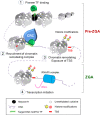Chromatin-linked determinants of zygotic genome activation
- PMID: 22965566
- PMCID: PMC11113722
- DOI: 10.1007/s00018-012-1143-x
Chromatin-linked determinants of zygotic genome activation
Abstract
The merging of the maternal and paternal genomes into a single pronucleus after fertilization is accompanied by a remarkable reconfiguration of chromatin in the newly formed zygote. The first stages of embryonic chromatin remodeling take place in the absence of ongoing transcription, during a species-specific developmental time-frame. Once post-fertilization chromatin states are organized, zygotic genome activation (ZGA) is initiated, and embryonic transcripts gradually take control of development. We review here transitions in chromatin modifications associated with the onset of ZGA, and the role of transcription factors and DNA motifs in the regulation of ZGA. We propose a model of sequential chromatin remodeling events preceding ZGA, leading to the onset of embryonic transcription.
Figures



Similar articles
-
The emergence of genome architecture and zygotic genome activation.Curr Opin Cell Biol. 2020 Jun;64:50-57. doi: 10.1016/j.ceb.2020.02.002. Epub 2020 Mar 19. Curr Opin Cell Biol. 2020. PMID: 32220807 Free PMC article. Review.
-
Mechanisms regulating zygotic genome activation.Nat Rev Genet. 2019 Apr;20(4):221-234. doi: 10.1038/s41576-018-0087-x. Nat Rev Genet. 2019. PMID: 30573849 Free PMC article. Review.
-
OBOX regulates mouse zygotic genome activation and early development.Nature. 2023 Aug;620(7976):1047-1053. doi: 10.1038/s41586-023-06428-3. Epub 2023 Jul 17. Nature. 2023. PMID: 37459895 Free PMC article.
-
Dppa2 and Dppa4 directly regulate the Dux-driven zygotic transcriptional program.Genes Dev. 2019 Feb 1;33(3-4):194-208. doi: 10.1101/gad.321174.118. Epub 2019 Jan 28. Genes Dev. 2019. PMID: 30692203 Free PMC article.
-
Dynamic Change of R-Loop Implicates in the Regulation of Zygotic Genome Activation in Mouse.Int J Mol Sci. 2022 Nov 18;23(22):14345. doi: 10.3390/ijms232214345. Int J Mol Sci. 2022. PMID: 36430821 Free PMC article.
Cited by
-
The model of "genetic compartments": a new insight into reproductive genetics.J Assist Reprod Genet. 2019 Mar;36(3):363-369. doi: 10.1007/s10815-018-1366-3. Epub 2018 Nov 12. J Assist Reprod Genet. 2019. PMID: 30421342 Free PMC article. Review.
-
RNA profiles of porcine embryos during genome activation reveal complex metabolic switch sensitive to in vitro conditions.PLoS One. 2013 Apr 29;8(4):e61547. doi: 10.1371/journal.pone.0061547. Print 2013. PLoS One. 2013. PMID: 23637850 Free PMC article.
-
A Novel Imprinted Gene NUWA Controls Mitochondrial Function in Early Seed Development in Arabidopsis.PLoS Genet. 2017 Jan 17;13(1):e1006553. doi: 10.1371/journal.pgen.1006553. eCollection 2017 Jan. PLoS Genet. 2017. PMID: 28095407 Free PMC article.
-
A Tremendous Reorganization Journey for the 3D Chromatin Structure from Gametes to Embryos.Genes (Basel). 2022 Oct 15;13(10):1864. doi: 10.3390/genes13101864. Genes (Basel). 2022. PMID: 36292750 Free PMC article. Review.
-
Nuclear distribution of RNA polymerase II and mRNA processing machinery in early mammalian embryos.Biomed Res Int. 2014;2014:681596. doi: 10.1155/2014/681596. Epub 2014 Apr 29. Biomed Res Int. 2014. PMID: 24868542 Free PMC article. Review.
References
-
- Bernstein BE, Mikkelsen TS, Xie X, Kamal M, Huebert DJ, Cuff J, Fry B, Meissner A, Wernig M, Plath K, Jaenisch R, Wagschal A, Feil R, Schreiber SL, Lander ES. A bivalent chromatin structure marks key developmental genes in embryonic stem cells. Cell. 2006;125:315–326. doi: 10.1016/j.cell.2006.02.041. - DOI - PubMed
-
- Mikkelsen TS, Ku M, Jaffe DB, Issac B, Lieberman E, Giannoukos G, Alvarez P, Brockman W, Kim TK, Koche RP, Lee W, Mendenhall E, O’Donovan A, Presser A, Russ C, Xie X, Meissner A, Wernig M, Jaenisch R, Nusbaum C, Lander ES, Bernstein BE. Genome-wide maps of chromatin state in pluripotent and lineage-committed cells. Nature. 2007;448:553–560. doi: 10.1038/nature06008. - DOI - PMC - PubMed
Publication types
MeSH terms
Substances
LinkOut - more resources
Full Text Sources

